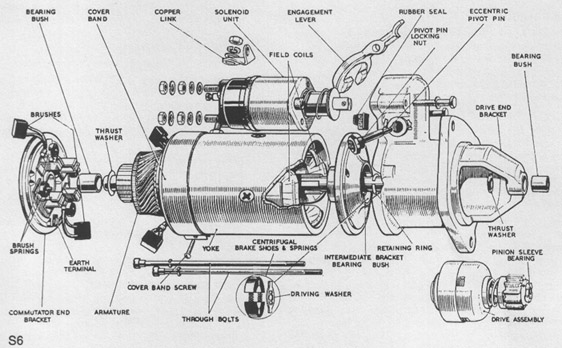With a large diagram at bottom of page
2. The lamps do not dim, the voltmeter
reading
remains steady at about 12 volts, and the motor
does not crank the engine.
Connect voltmeter from solenoid terminal 'BAT',
and starter yoke, operate starter:-
No volts indicated.
a) Poor lug connections at battery.
b) Bad earth connection.
c) Broken starter lead, battery to starter.
Full volts i.e., 12-14 volts indicated.
a) Faulty solenoid switch.
b) Open circuit in starter - check brushes.
Starter Motor
Model • CA45
General Description
Designed for flange mounting, the C.A.45 starter motor
has a uniform cylindrical shape with no surface pro-
trusion. This is because the solenoid and main switch
assemblies are housed within the drive end-shield,
around (i.e.. co-axially with) the armature shaft.
The essential feature of the co-axial starter is that,
the pinion alone moves axially to engage the engine
flywheel. There is no longitudinal movement of the
whole armature assembly, as in the axial types.
Smooth engagement of the pinion with the engine fly-
wheel is constantly ensured by using two-stage opera-
tion of the solenoid and switch mechanisms. Thus the
risk of damage to both pinion and flywheel, through
faulty meshing, is practically eliminated.
In construction, the starter consists of three main
sections, into which it can be easily dismantled.
1. The solenoid switch-gear and pinion assembly
housed in the drive end-shield.
2. The armature, shaft and commutator assembly.
3. The yoke, pole-piece and field-coil assembly.
Ready access is possible therefore, to those parts most
likely to require adjustment, such as the switchgear
and commutator assemblies.
The starter is designed for working off a 12 volt supply,
with 17 amps solenoid current.
Testing on the Vehicle
Ensure thai the battery is in a charged condition.
Switch on 'he lamps and operate the starter button. If
the starter fails to function, but the lights maintain full
brilliance, check the switch and battery connections to
the starter and all external leads. Sluggish action of the
starter can be caused by a poor or faulty connection.
Difficulty in smooth engagement between starter and
engine flywheel is probably due to dirt on the starter-
shaft helices preventing free pinion movement. The
shaft should be thoroughly cleaned with kerosene
followed by the application of a small quantity of Caltex
Thuben 90 or SAE 90 oil.
Operating the Starter
When starting the engine the following points
should be rigidly observed
1. Press the starter button firmly and release it
Immediately the engine fires.
2. If the engine does not fire at once, let it come to
rest before pressing the switch again.
3. Do not run the battery down by keeping the starter
switch pressed when the engine refuses to start.
Ascertain the cause.
4. On some engines it is often helpful to depress the
clutch when starting.
5. Do not operate the starter when the engine is run-
ning as serious damage may occur to both starter
and flywheel.

© Dodge50.co.uk™ 2002